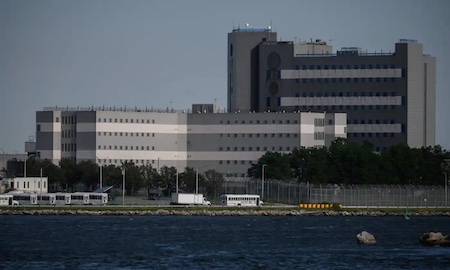|
By Dani Anguiano | The Guardian
from The Guardian
Friday, Jun 24, 2022
US prison workers produce $11bn worth of goods and services a year for pittance
New report by American Civil Liberties Union says incarcerated laborers are either poorly compensated or not at all
 |
| A general view shows the Rikers Island facility. Photograph: Ed Jones/AFP/Getty Images |
Incarcerated workers in the US produce at least $11bn in goods and services annually but receive just pennies an hour in wages for their prison jobs, according to a new report from the American Civil Liberties Union (ACLU).
Nearly two-thirds of all prisoners in the US, which imprisons more of its population than any other country in the world, have jobs in state and federal prisons. That figure amounts to roughly 800,000 people, researchers estimated in the report, which is based on extensive public records requests, questionnaires and interviews with incarcerated workers.
ACLU researchers say the findings outlined in Wednesday’s report raise concerns about the systemic exploitation of prisoners, who are compelled to work sometimes difficult and dangerous jobs without basic labor protections and little or no training while making close to nothing.
Most incarcerated workers are tasked with general prison maintenance that is crucial to keep the facilities running, according to the ACLU researchers, who worked with the University of Chicago Law School’s Global Human Rights Clinic.
“State governments and the prison system are extracting tremendous value from a captive and exploited workforce all while claiming they can’t afford to pay them a liveable wage,” said Jennifer Turner, the principal author of the report.
More than 80% of incarcerated laborers do general prison maintenance, including cleaning, cooking, repair work, laundry and other essential services. For paid non-industry jobs, workers make an average of 13 cents to 52 cents an hour, according to the report. Seven states – Alabama, Arkansas, Florida, Georgia, Mississippi, South Carolina and Texas – pay nothing for the vast majority of prison work.
Incarcerated workers who are paid often see most of their pay withheld for “taxes, room and board expenses, and court costs”, the report states.
“We are saving [the prisons] millions of dollars and getting paid pennies in return … All the jobs we are doing in prison are not really benefiting us; it is more benefitting the prison system. I work a job making $450 for a whole year,” said Latashia Millender, an inmate at a prison in Illinois, according to the report.
Public officials have acknowledged that the work of these unpaid and poorly compensated incarcerated laborers is crucial: “There’s no way we can take care of our facilities, our roads, our ditches, if we didn’t have inmate labor,” Warren Yeager, a former Gulf county, Florida, commissioner said to the Florida Times-Union.
Other officials have said they oppose new sentencing and parole laws that would reduce the pool of incarcerated workers, according to the report. Steven Prator, a Louisiana sheriff, said: “We need to keep some out there, that’s the ones that you can work, that pick up trash, the work release program, but guess what? Those are the ones that they are releasing … the good ones, that we use every day to wash cars, change oil in our cars, to cook in the kitchen, to do all that where we save money … well, they are gonna let them out.”
More than 75% of workers told ACLU researchers if they can’t work or decline to do so, they are subject to punishment ranging from solitary confinement to the loss of family visits to denials of sentence reductions.
Most incarcerated workers are not provided with skills and training for their work that would help them secure jobs when they are released, Turner said; 70% said they did not receive any formal job training, and 70% said they couldn’t afford essentials such as soap and phone calls with their wages.
“The United States has a long, problematic history of using incarcerated workers as a source of cheap labor and to subsidize the costs of our bloated prison system,” said Turner, a principal human rights researcher with the ACLU’s Human Rights Program.
“Incarcerated workers are stripped of even the most minimal protections against labor exploitation and abuse. They are paid pennies for their work in often unsafe working conditions even as they produce billions of dollars for states and the federal government.”
Some workers make slightly higher wages working for “state prison industries”, which are typically state-owned programs run by the corrections department to produce goods or provide services for other government agencies. That work includes manufacturing furniture, cleaning supplies and uniforms for other government workers, washing laundry for public hospitals or universities and working for call centers of the department of motor vehicles.
In 2021, more than 51,000 people held industry jobs, accounting for 6.5% of prison labor, the researchers found. Those workers are paid 30 cents to $1.30 an hour on average. In Oregon, for example, the DMV pays incarcerated workers $4 to $6 a day, while a worker outside of prison doing the same DMV job makes an average of $80 a day.
Incarcerated workers in prison industries programs generated goods and services worth $2.09bn nationally in 2021, the authors found, citing estimates from the National Correctional Industries Association, a prison industry group. The researchers estimated that the maintenance work of prisoners is worth $9bn a year, but cautioned that there was no centralized data on the value of this work and that the figure was probably an undercount and a rough estimate from earlier studies.
The authors of the report are calling for extensive changes around the use of prison labor, including ensuring that such work is voluntary and provides workers with the same wages and protections granted to other workers as well as work programs that give incarcerated workers marketable skills and training.
Source URL
|
 Print This Print This

|

